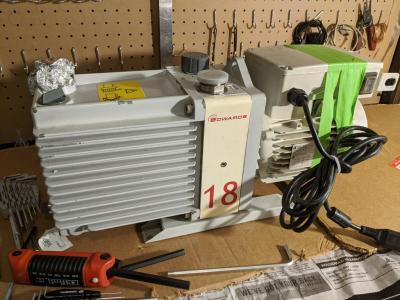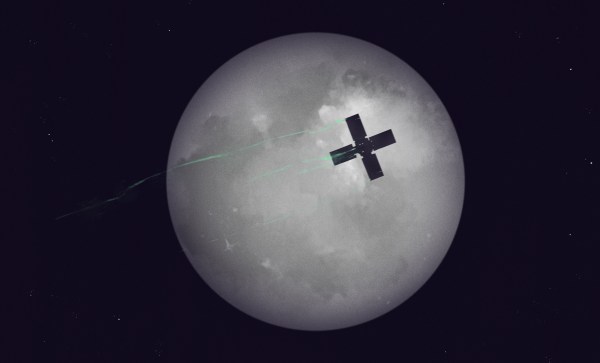Say what you want about the wisdom of keeping a 50-year-old space mission going, but the dozen or so people still tasked with keeping the Voyager mission running are some major studs. That’s our conclusion anyway, after reading about the latest heroics that revived a set of thrusters on Voyager 1 that had been offline for over twenty years. The engineering aspects of this feat are interesting enough, but we’re more interested in the social engineering aspects of this exploit, which The Register goes into a bit. First of all, even though both Voyagers are long past their best-by dates, they are our only interstellar assets, and likely will be for centuries to come, or perhaps forever. Sure, the rigors of space travel and the ravages of time have slowly chipped away at what these machines can so, but while they’re still operating, they’re irreplaceable assets.
thruster14 Articles
Liquid Metal Ion Thrusters Aren’t Easy
What do scanning electron microscopes and satellites have in common? On the face of things, not much, but after seeing [Zachary Tong]’s latest video on liquid metal ion thrusters, we see that they seem to have a lot more in common than we’d initially thought.
As you’d expect with such a project, there were a lot of false starts and dead ends. [Zach] started with a porous-emitter array design, which uses a sintered glass plate with an array of tiny cones machined into it. The cones are coated in a liquid metal — [Zach] used Galinstan, an alloy of gallium, indium, and tin — and an high voltage is applied between the liquid metal and an extraction electrode. Ideally, the intense electric field causes the metal to ionize at the ultra-sharp tips of the cones and fling off toward the extraction electrode and into the vacuum beyond, generating thrust.
Getting that working was very difficult, enough so that [Zach] gave up and switched to a slot thruster design. This was easier to machine, but alas, no easier to make work. The main problem was taming the high-voltage end of things, which seemed to find more ways to produce unwanted arcs than the desired thrust. This prompted a switch to a capillary emitter design, which uses a fine glass capillary tube to contain the liquid metal. This showed far more promise and allowed [Zach] to infer a thrust by measuring the tiny current created by the ejected ions. At 11.8 μN, it’s not much, but it’s something, and that’s the thing with ion thrusters — over time, they’re very efficient.
To be sure, [Zach]’s efforts here didn’t result in a practical ion thruster, but that wasn’t the point. We suspect the idea here was to explore the real-world applications for his interests in topics like electron beam lithography and microfabrication, and in that, we think he did a bang-up job with this project.
Voyager 1 Completes Tricky Thruster Reconfiguration
After 47 years it’s little wonder that the hydrazine-powered thrusters of the Voyager 1, used to orient the spacecraft in such a way that its 3.7 meter (12 foot) diameter antenna always points back towards Earth, are getting somewhat clogged up. As a result, the team has now switched back to the thrusters which they originally retired back in 2018. The Voyager spacecraft each have three sets (branches) of thrusters. Two sets were originally intended for attitude propulsion, and one for trajectory correction maneuvers, but since leaving the Solar System many years ago, Voyager 1’s navigational needs have become more basic, allowing all three sets to be used effectively interchangeably.
The first set was used until 2002, when clogging of the fuel tubes was detected with silicon dioxide from an aging rubber diaphragm in the fuel tank. The second set of attitude propulsion thrusters was subsequently used until 2018, until clogging caused the team to switch to the third and final set. It is this last set that is now more clogged then the second set, with the fuel tube opening reduced from about 0.25 mm to 0.035 mm. Unlike a few decades ago, the spacecraft is much colder due energy-conserving methods, complicating the switching of thruster sets. Switching on a cold thruster set could damage it, so it had to be warmed up first with its thruster heaters.
The conundrum was where to temporarily borrow power from, as turning off one of the science instruments might be enough to not have it come back online. Ultimately a main heater was turned off for an hour, allowing the thruster swap to take place and allowing Voyager 1 to breathe a bit more freely for now.
Compared to the recent scare involving Voyager 1 where we thought that its computer systems might have died, this matter probably feels more routine to the team in charge, but with a spacecraft that’s the furthest removed man-made spacecraft in outer space, nothing is ever truly routine.
Hackaday Links: September 1, 2024
Why is it always a helium leak? It seems whenever there’s a scrubbed launch or a narrowly averted disaster, space exploration just can’t get past the problems of helium plumbing. We’ve had a bunch of helium problems lately, most famously with the leaks in Starliner’s thruster system that have prevented astronauts Butch Wilmore and Suni Williams from returning to Earth in the spacecraft, leaving them on an extended mission to the ISS. Ironically, the launch itself was troubled by a helium leak before the rocket ever left the ground. More recently, the Polaris Dawn mission, which is supposed to feature the first spacewalk by a private crew, was scrubbed by SpaceX due to a helium leak on the launch tower. And to round out the helium woes, we now have news that the Peregrine mission, which was supposed to carry the first commercial lander to the lunar surface but instead ended up burning up in the atmosphere and crashing into the Pacific, failed due to — you guessed it — a helium leak.
Continue reading “Hackaday Links: September 1, 2024”
NASA Lunar Probe Finds Out It’s Not Easy Being Green
If you’re a space fan, these are very exciting days. There’s so much happening overhead that sometimes it can be difficult to keep up with the latest news. Artemis I just got back from the Moon, the International Space Station crew are dealing with a busted Soyuz, SpaceX is making incredible progress with their Starship architecture, CubeSats are being flung all over the solar system, and it seems like every month a new company is unveiling their own commercially-developed launch vehicle.

So with everything going on, we wouldn’t be surprised if you haven’t heard about NASA’s Lunar Flashlight mission. The briefcase-sized spacecraft was launched aboard a special “rideshare” flight of SpaceX’s Falcon 9 rocket back on December 11th — tagging along with two other craft heading to our nearest celestial neighbor, the Japanese Hakuto-R lander, and a small rover developed by the United Arab Emirates. There was a time when a launch like that would have been big news, but being that it was only the second of seven launches that SpaceX performed in December alone, it didn’t make many headlines.
But recently, that’s started to change. There’s a growing buzz around Lunar Flashlight, though unfortunately, not for the reasons we’d usually hope. It seems the diminutive explorer has run into some trouble with its cutting-edge “green” propellant system, and unless the issue can be resolved soon, the promising mission could come to an end before it even had a chance to start.
Continue reading “NASA Lunar Probe Finds Out It’s Not Easy Being Green”
Help Thrust Open Source Satellites To The Next Level
To place a satellite in orbit satisfactorily it is necessary not only to hitch a ride on a rocket, but also to put it in the right orbit for its task, and once it is there, to keep it there. With billions of dollars or roubles of investment over six decades of engineering behind them the national space agencies and commercial satellite builders solved these problems long since, but replicating those successes for open source microsatellites still represents a significant engineering challenge. One person working in this field is [Michael Bretti], who is doing sterling work with a shoestring budget on open source electric thrusters for the smallest of satellites, and he needs your help in crowdfunding a piece of equipment.

As part of his testing he has a vacuum chamber, and when he places a thruster inside it he has to create a space-grade vacuum . This is no easy task, and to achieve it he has two pumps. The first of these, a roughing pump, is a clapped-out example that has clearly reached the end of its days, and it is this that he needs your help to replace. His GoFundMe page has a modest target of only $4,200 which should be well within the capabilities of our community in reaching, and in supporting it you will help the much wider small satellite community produce craft that will keep giving us interesting things from space for years to come.
We’ve mentioned his work before here at Hackaday, and we hope that in time we’ll have a chance to look in more detail at his thrusters. Meanwhile you can follow along on Twitter.
Thanks [Bruce Perens K6BP] for the tip.
Open-Source Satellite Propulsion Hack Chat
Join us on Wednesday, December 11 at noon Pacific for the Open-Source Satellite Propulsion Hack Chat with Michael Bretti!
When you look back on the development history of any technology, it’s clear that the successful products eventually reach an inflection point, the boundary between when it was a niche product and when it seems everyone has one. Take 3D-printers, for instance; for years you needed to build one if you wanted one, but now you can buy them in the grocery store.
It seems like we might be getting closer to the day when satellites reach a similar inflection point. What was once the province of nations with deep pockets and military muscles to flex has become far more approachable to those of more modest means. While launching satellites is still prohibitive and will probably remain so for years to come, building them has come way, way down the curve lately, such that amateur radio operators have constellations of satellites at their disposal, small companies are looking seriously at what satellites can offer, and even STEM programs are starting to get students involved in satellite engineering.
Michael Bretti is on the leading edge of the trend toward making satellites more DIY friendly. He formed Applied Ion Systems to address one of the main problems nano-satellites face: propulsion. He is currently working on a range of open-source plasma thrusters for PocketQube satellites, a format that’s an eighth the size of the popular CubeSat format. His solid-fuel electric thrusters are intended to help these diminutive satellites keep station and stay in orbit longer than their propulsion-less cousins. And if all goes well, someday you’ll be able to buy them off-the-shelf.
Join us for the Hack Chat as Michael discusses the design of plasma thrusters, the details of his latest testing, and the challenges of creating something that needs to work in space.
 Our Hack Chats are live community events in the Hackaday.io Hack Chat group messaging. This week we’ll be sitting down on Wednesday, December 11 at 12:00 PM Pacific time. If time zones have got you down, we have a handy time zone converter.
Our Hack Chats are live community events in the Hackaday.io Hack Chat group messaging. This week we’ll be sitting down on Wednesday, December 11 at 12:00 PM Pacific time. If time zones have got you down, we have a handy time zone converter.
Click that speech bubble to the right, and you’ll be taken directly to the Hack Chat group on Hackaday.io. You don’t have to wait until Wednesday; join whenever you want and you can see what the community is talking about.

















